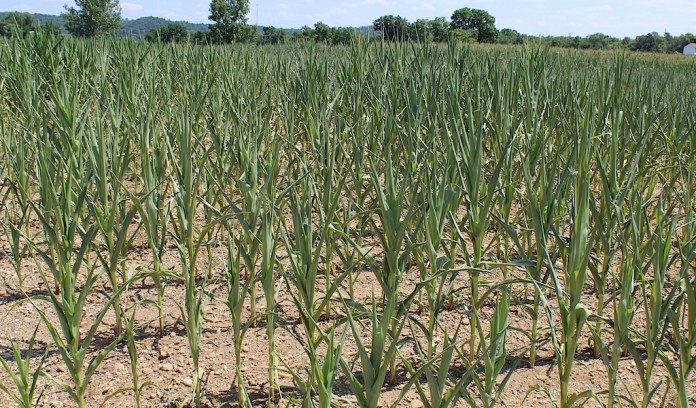The problem with a weather market is that it is fickle and subject to conflicting reports. It is hard to decide what the truth is, so the market function is to guess ahead of time what the future price will be.
We are not doing a very good job of this right now. To say prices have been volatile is an understatement.
Wide ranging
July corn futures had a range of 29 cents June 21, for example. At the biscuit break (the market stops trading from 8:45 to 9:30 a.m. EST) prices were sharply lower.
July corn futures were down 15 cents; November corn futures were down 30-some. But, by 11 a.m., we had corn up three cents and soybeans up 14.
Traders were struggling in a market defined by fundamentals to decide what the fundamentals were.
The first of the morning, a source had noted that “anyone who had needed rain had got rain” over the weekend. Yet, as I talked to 20 people on a conference call, it was apparent that they were not just hoping for rain, they were desperate.
Varying weather reports
While forecasts talked of rain, especially coming up the Ohio Valley and overnight in Chicago, the actual farmers in Southern Minnesota and up into the Dakotas were talking about corn curled up and already seeing permanent damage to the crop.
The morning of June 22, market reports were predicting lower prices as rain was coming through. They were talking about Iowa and area east of the Mississippi, however.
Weather reports for the upper Corn Belt are still dry. So, we have a market that is predicting better crops and lower prices and a large growing area were farmers are not seeing the results of those eastern forecasts.
Putting a price on corn while talking to those farmers is difficult. Even while Chicago traders think they see improvement in weather, western farmers see crops that scare them. So, we get volatility.
Soon, we will be trading off September futures. They are 88 cents less than July futures right now. Maybe as September becomes the lead month, futures they will close that gap, but maybe not.
In early May, July corn futures got up to $7.351⁄4. We were trading $6.551⁄2 the morning of June 22. That 80 cents pretty much defines volatility.
If the weather forecasts that the Chicago traders are watching materialize, we will go lower. If the crop conditions the farmers are watching get worse, we will go higher. Like the old saying goes, “You pays your money and you takes your chance.”
Crop conditions
That gets us to crop conditions. The U.S. Department of Agriculture reported June 21 that Ohio corn is rated at 60% good, and 16% excellent for a total of 76%. This is believable, as we have had rain, and the crops, although short, look good.
The U.S. is rated 54 plus 11 for a 65% good and excellent rating. That is 3% less than last week and 8% off the five-year average.
Soybean conditions have been released for Ohio as 58 plus 14 for a 72% total. This is close to normal. The U.S. condition is reported at 51 plus nine, for 60%. That is just 2% off last week, but 10% off the average of 70%.
Remember, the soybean condition this time of year is not as critical as the corn condition. It was being said the morning of June 22 that the corn and bean condition reports are not as bad as the market expected.
Yet, the corn prices were down nine cents for new crop corn and only two cents for new crop beans. Maybe the traders don’t really believe the condition reports.
The traders were surprised by the condition reports for spring wheat. They expected a drop of 2%, and got 10% in the report.
Anecdotal reports June 21 have spring wheat yields from nothing to 20 bushels in some cases. This comes with significantly lower planted acres. The winter wheat harvest has reached Kansas, and is 3% behind normal progress, at 17%.













